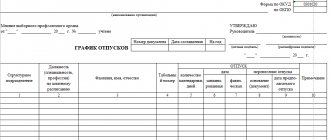When applying for a job and interviewing at a new company, in addition to the salary, we are almost always interested in the promised working conditions. This is not surprising, because different fields of activity have their own work schedules. Based on an additional agreement, an employee can be provided with an individual work schedule, taking into account the specifics of his activity - it may include alternating day and night shifts, staggered hours and other features.
But many employees and employers are faced with some restrictions every now and then. The fact is that there are certain requirements for drawing up a schedule, non-compliance with which may become a violation of the labor legislation of the Russian Federation. That is, you most likely will not be able to distribute your working time according to your own wishes. We’ll tell you how to correctly create a work schedule for employees and what needs to be taken into account.
When does a shift work schedule apply?
A shift schedule is a fairly common phenomenon. It is used in a wide variety of industries, most often in companies with a continuous round-the-clock production cycle - the need for its use here is due to the fact that equipment downtime is unacceptable, because they lead to system failures and significant financial losses. But regular, timely replacement of personnel leads to an increase in the volume of output, improved labor productivity and, as a result, greater profits.
Also, a shift schedule is common in other areas, for example, in medical institutions, security structures, firefighters, gas services, rail and transport transportation, air travel, etc.
Why is it necessary to compile it?
A shift schedule is simply necessary for some activities.
For example, it is needed for facility guards, some drivers, police officers, ambulance stations, fire and gas services, and for remote control workers of security organizations. Its relevance is due to the fact that a large number of misfortunes and illegal actions of third parties happen in the dark. Also, round-the-clock operation allows you to fully utilize the useful capacity of equipment in industrial enterprises. Machines and devices, operating at night, provide greater efficiency with minor losses in electricity (at night it costs less). In this way, it is possible to significantly increase the volume of production and provision of services, and increase production output. This has a positive impact on the company's profit.
Shift work is carried out both on railway trains and on airline flights. Otherwise, an unscheduled interruption in international and intercity communications can lead to irreparable consequences: flight delays, delays and disasters.
Why do you need a shift schedule?
The shift schedule is one of the most important internal documents of the company.
Based on the schedule, employees' working hours are recorded and their wages are subsequently calculated.
Thus, it relates not only to methods of organizing work at an enterprise, but is also a serious accounting form.
We must not forget that if the company provides for shift work, then the availability of the schedule is necessarily checked by government supervisory structures (for example, the labor inspectorate and the tax service). The absence of this document may result in the imposition of an administrative penalty on the enterprise and its management in the form of a fairly large fine.
Summarized accounting
It involves taking into account a longer period than a day or a week. Such a system provides more than just time measurement. Summary accounting is considered a specific form of organizing labor activity. The minimum duration of work is a month, the maximum is a year.
The essence of accounting is that the duration of work during the day for a period on average is equal to the norm. Such a system is provided for enterprises where, due to the specifics of the activity, other types of work schedules (for example, daily or weekly) cannot be established. At the same time, the duration of time for performing professional tasks should not exceed the standard for the accounting period.
Summarized accounting can be weekly, quarterly, annual, monthly. This type of schedule is often used in construction work organized on a rotational basis at transport enterprises.
The maximum duration of a shift with such time accounting is not limited by law. In practice, it ranges from 8 to 12 hours.
Legislative regulation, mandatory conditions
The shift schedule is regulated by law, namely Art. 372 of the Labor Code of the Russian Federation (Part 3 of Article 103 of the Labor Code of the Russian Federation). When introducing it into an organization, it is required to strictly comply with the norms and conditions of the above section of the Labor Code of the Russian Federation.
The rules for operating in this mode are spelled out here quite thoroughly and clearly. There is no point in listing them in this article, but some simply need to be emphasized:
- the weekly working hours in the sum of all shifts should not exceed forty hours;
- every shift people should be given a lunch break (its duration is determined individually - from 30 minutes to 2 hours);
- employees must be provided with uninterrupted rest for 42 hours every week;
- the employer is obliged to indicate to employees that it is inadmissible for them to perform their duties in two shifts in a row (except in emergency cases) - and strictly monitor this.
If an organization feels the need to use a shift schedule for different categories (positions) of employees, then for each of them the duration of the shift can be determined separately (such situations occur in transport companies - one work mode is used for drivers, another for dispatchers, and another for service personnel). third).
When creating a schedule, one more important point should be taken into account - if most of it falls at night, then the shift should automatically be reduced by an hour.
All other working conditions must also comply with the law, including in matters relating to the payment of wages, provision of sick leave, vacation, etc.
Duties of the parties
It must be said that when applying the provisions of Article 101 of the Labor Code, the employer does not have to obtain consent from either the employee or the trade union to engage in work beyond the standard duration. This right is initially stipulated in the employment contract.
The employee, in turn, cannot refuse to perform his duties on an irregular schedule. Otherwise, his actions will be regarded as a gross disciplinary offense.
The establishment of an irregular regime, however, does not mean that employees will not be subject to the provisions of the Labor Code on norms of rest and work time. In this regard, their involvement in work activities beyond the shift duration determined for them can only be carried out sporadically.
What is not considered a shift schedule
Some personnel officers mistakenly believe that the work schedule is a day after two/three, two days after two, etc., refers to shift work. If you carefully read the labor legislation of the Russian Federation, it turns out that this is not so. A group of workers, performing their job duties during one day and being replaced by others the next day, works in a regime fixed within the enterprise, but there is no clear procedure for developing such a regime, its coordination and approval.
Characteristics
An enterprise can establish one of the following types of work schedules according to the Labor Code of the Russian Federation:
- Daily 5-day work with 2 days off.
- Daily six-day work with 1 day off.
- Working week with days off on a rotating schedule.
These regimes are provided for in Article 100 of the Labor Code. In Art. 104 of the Code provides for the possibility of applying summarized time tracking at an enterprise.
Daily types of work schedules are in practice called single-shift.
Some points regarding payment
The calculation of remuneration for a shift schedule is somewhat different from the standard one. The specificity here is that the number of working hours according to the regime established at the enterprise may differ from the norm established by law, both upward and downward (the so-called planned overtime or underwork).
To ensure that there are no errors in salary calculations, at the end of the accounting period, the following parameters should be reconciled: the number of working hours in accordance with the norm and their number, based on real indicators. If, when comparing, the second indicator is greater than the first, you will need to calculate and pay the employee extra for overtime.
If an employee’s shift falls on a day off, then it is paid as usual (this is justified by the peculiarities of the shift conditions). If he is forced to work on a holiday (state non-working days are specified in the Labor Code of the Russian Federation), then he must be paid at the appropriate standard rate, i.e. in double size.
Consolidating the work order
If the management of an enterprise decides to use a shift work schedule, it must enshrine this norm in its accounting policies, or more precisely, in its Internal Regulations.
If the company has a trade union cell, these Rules, including those regarding shift work, must be approved by its representative. A five-day period is allotted for interaction with the trade union - during this period, trade unionists must either approve the Rules presented to them or challenge them with evidence.
It is also possible to establish the use of a shift schedule in a collective agreement.
In addition to the internal regulations and the collective agreement, the clause on shift work must be spelled out in sections of individual employment contracts with employees, indicating the number of hours per shift and other parameters.
Job categories
As mentioned above, not all employees can be subject to an irregular work schedule. Types of positions may be provided not only in a collective agreement or work rules, but also in industry, regional and other regulatory documents.
An irregular schedule may apply to persons:
- Technical, administrative, economic, management personnel.
- The labor activity of which cannot be taken into account in time.
- Distributing their working time at their own discretion.
- The schedule of which is divided into parts of indefinite duration.
The process of creating a shift schedule
The first practical stage in implementing a shift schedule is an order for its creation, issued on behalf of the director of the organization. It contains instructions to create a shift schedule, period, responsible person and other necessary information.
Sample order for approval of shift schedule
Next comes the actual preparation of the document. The interests of the employer and employee must be taken into account here.
The schedule is formed in advance - at least thirty days before the start of the shift.
Each employee mentioned in the document must be familiarized with it against signature. Thus, he indicates that he agrees with this mode of operation.
After development, coordination and final approval, the schedule will be binding both for the management of the enterprise and for the employees designated in it.
Is it possible to change the information in it?
Changes are allowed to the approved shift schedule, but only as a last resort and in compliance with certain rules.
Firstly, if changes occur at the initiative of the employer, he must notify his subordinates in advance about them and obtain their written consent - without them, making changes legally will be problematic.
If one of the employees asks to change the shift schedule, he must draw up a special application addressed to the manager. The application must indicate the reasons for the request (it must be respectful with appropriate written justifications), then the consent of the other employees to whom the document concerns must be obtained. If colleagues and management managed to reach a compromise, a new order is formed, on the basis of which the necessary adjustments are made to the schedule.
Changing working hours
Sometimes, for certain reasons, a change in working hours and, as a result, in the schedule is required. The legislation does not prevent this. The initiators of adjustments can be both the employer and the employee. These adjustments are possible by mutual agreement of the parties or unilaterally by the employer. If the rental agreement contains a condition on working hours, then changing these conditions is permissible only by agreement of the parties.
If the employee agrees to such changes, it is necessary to conclude an additional agreement setting out new working conditions. If the initiator of the changes is an employee, then he is obliged to notify the employer in advance. For this purpose, a statement is written on his behalf, which will subsequently be the starting point for issuing an order and concluding an additional agreement. A sample application is here.
In some cases, the law does not prohibit changing working hours
Changing working conditions is possible not only for one employee, but also for the team as a whole. Before making changes to the work process, the employer must notify the employee (or the entire team) about this. An example of a notification is here. The procedure for changing the mode is as follows:
- Submit an order to adjust the necessary items in the work schedule. You can see a sample here.
- Familiarize employees with the terms of innovation.
- Make adjustments to the employee agreement and the PVTR (local regulatory act regulating the hiring and dismissal of employees). In case of temporary changes, PVTR should not be adjusted.
The order must contain the following information:
- date of introduction of the new schedule;
- if the current changes are temporary, indicate their start and completion dates;
- indicate changes in such elements of the work regime as working day, week, etc.;
- indicate all possible breaks in the labor process.
It must be remembered that the manager has no reason to increase the employee’s workload on an ongoing basis. The employee, in turn, has the opportunity to either agree with the proposed changes or quit his job. If an employee has expressed a desire to make adjustments to the work process, justifications must be provided for this (possible personal illness or illness of one of the household members, etc.). The application is written in free form, but it is understood that it will contain the following information:
- date of desired transfer to the new regime;
- description of the current mode;
- indication of desired working hours;
- justification of the request with evidence attached.
As a result, an additional agreement is drawn up to the employee’s current contract, which reflects the changes made. Please see an example of such an agreement. The employee must familiarize himself with this document two months before the changes in the working regime.
How to coordinate with employees
The shift schedule must be agreed upon with employees in advance, as mentioned above - no later than thirty days before the start of the first shift.
Signatures of consent can be placed directly on the schedule itself, or you can make a separate sheet for this.
If the second option is chosen, then you need to make a table on the approval sheet, enter all the employees there and collect their autographs (with the date they were signed). This document will be an official attachment to the shift schedule.
Features of the formation of a shift schedule, general information
If you are tasked with creating a shift schedule, and you have no idea how exactly it is formed, read our recommendations - they will give you an accurate idea of this document. Also check out the example of filling it out - based on it you can easily create your own form.
Before moving on to a detailed description of the schedule, we provide general information about the document. Let's start with the fact that there is no unified form of the schedule. This means that it can be written in free form or according to the model approved in the accounting policy of the organization. In this case, the method of forming the form must be reflected in the company’s regulations.
Regardless of which scheduling method is chosen, the document must contain a number of mandatory data:
- Company details;
- information about the place and time of compilation;
- the schedule itself.
The form must be certified by several persons. Firstly, by those employees in respect of whom it was formed, secondly, by the head of a structural unit and, thirdly, by the director of the company.
It is not necessary to certify the form with a seal - this should be done only when such a condition is in the company’s local documentation.
The schedule can be drawn up on a simple blank sheet of paper (preferably A4 format) or on the organization’s letterhead (if such a requirement is established by management). You can write it manually or on a computer (with mandatory subsequent printing).
How to take into account the shift schedule
All schedules developed at the enterprise are subject to mandatory registration in the appropriate accounting journal. After carrying out all the necessary procedures with them (development, coordination, approval, familiarization), they are transferred for storage to the company’s HR department. Here they are filed in a separate folder with other similar documents. Access to the place of their detention for unauthorized people should be limited.
The duration of their storage is indicated either in local acts of the organization, or is established by the legislation of the Russian Federation (but not less than five years). After this period has expired, the schedules can be disposed of in accordance with the procedure established by law.








